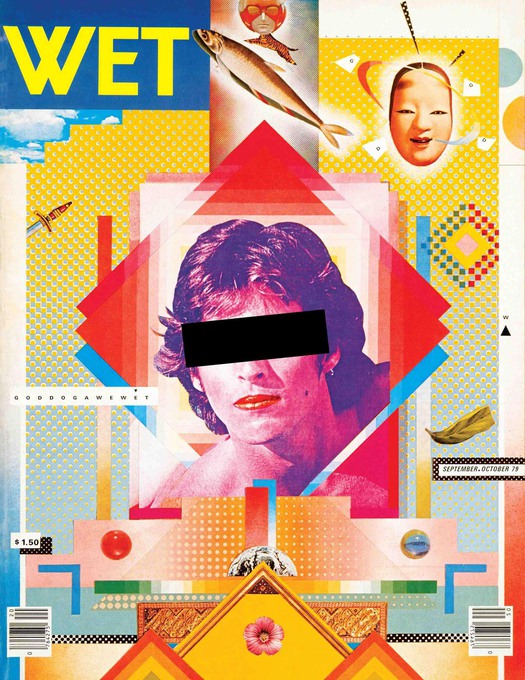
April Greiman with Jayme Odgers, Wet magazine cover, 1979. Source: Victoria and Albert Museum, London
The exhibition about postmodernism and design now running at the Victoria and Albert Museum in London ends with a defiant assertion: “like it or not we are all postmodern now.” And before Postmodernism: Style and Subversion, 1970-1990 had even opened at the end of September, the novelist and critic Hari Kunzru concluded a preview essay with much the same kind of observation: “We have lived through the end of postmodernism and the dawning of postmodernity.”
Do you think of yourself that way — as a postmodern person? Most probably you don’t. Postmodernism may have dominated the academy for more than a decade, but it was never a term that commanded much public understanding, let alone affection. I have a file full of semi-baffled think pieces published in the British press in the 1980s in an attempt to explain what this then fashionable buzzword was all about. The day the exhibition opened, the Observer newspaper dispatched its man to the V&A to find out “exactly what po-mo means.” Claiming to have discovered only a mood of “pre-emptive ennui” and puzzlement among the exhibition’s early visitors, he filed his report apparently none the wiser.
It certainly doesn’t help that even postmodernism’s proponents, who tended to be theorists rather than artists or designers, were always at pains to say how slippery the concept was, and hard to define. The exhibition’s curators, Glenn Adamson and Jane Pavitt, offer the same disclaimer in their foreword to the exhibition book: “the reader will not find anywhere in this book, or the exhibition it accompanies, a single handy definition of postmodernism.” That doesn’t mean that the book and (in a necessarily simpler way) the show avoid the issue — they offer many rewarding perspectives on the subject. But any attempt to reduce such an intricate set of cultural factors across so many kinds of art, design and media to a brief, all-encompassing definition would be a misrepresentation. We like to think we are complex people living in a complex world. So why would we expect an explanation of our many-layered culture to be easy?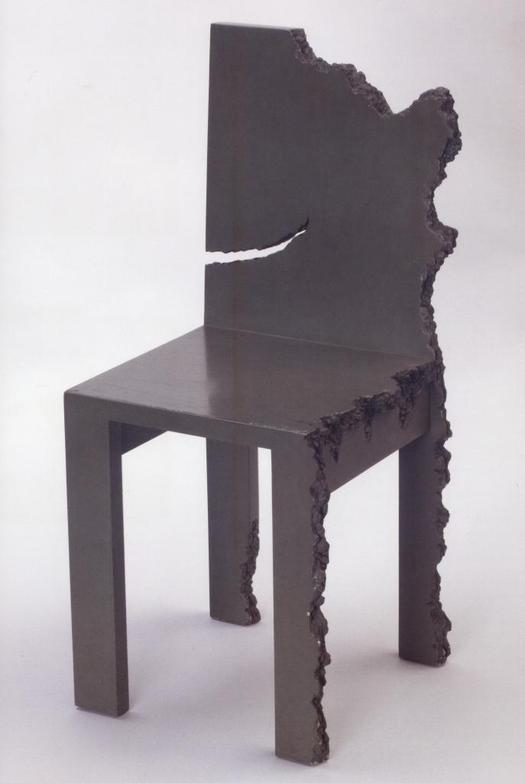
Howard Meister, Nothing Continues to Happen chair, 1980. Photograph: V&A, London
The added complication is the entirely valid distinction that Kunzru draws between postmodernism as a movement in the arts and postmodernity as an epoch with implications for every area of culture and society. Postmodernism in the stylistic sense might be over as movement, though there was no unitary postmodern style, but postmodernity is arguably still our cultural condition, as Adamson and Pavitt also imply. This divide was always going to be a tricky issue for the curators to negotiate and they make it clear from the outset that their subject is “postmodernism rather than postmodernity in general — that is a set of intentional design strategies, not the overarching condition that made them possible.” One probable reason for this decision is that postmodernity is simply too complicated to reference and explain in short introductory wall texts, which would have to be loaded with great gobbets of Jameson and Lyotard. Large-scale exhibitions in public museums must always strike a balance between doing a subject adequate intellectual justice and appealing to ordinary visitors who are likely to know little or nothing about the theme.
For visitors of a certain age — my teens and 20s fell within the exhibition’s time span — walking around Postmodernism is like seeing key signposts in your early cultural life flash before your eyes, though not necessarily in the original order. It’s entirely fitting that architecture, one of the strongest and most compelling sections, comes first (there’s a terrific room devoted to Venturi and Scott Brown in Las Vegas), but for many visitors it will be pop and rock music, album covers and videos, that first signaled the postmodern “turn.” In 1978, I tuned into the retro-constructivist references on the cover of Kraftwerk’s The Man Machine, the mournful yet oddly exhilarating sense that some version of the future had already occurred, several years before I knew that such a thing as postmodern architecture existed.
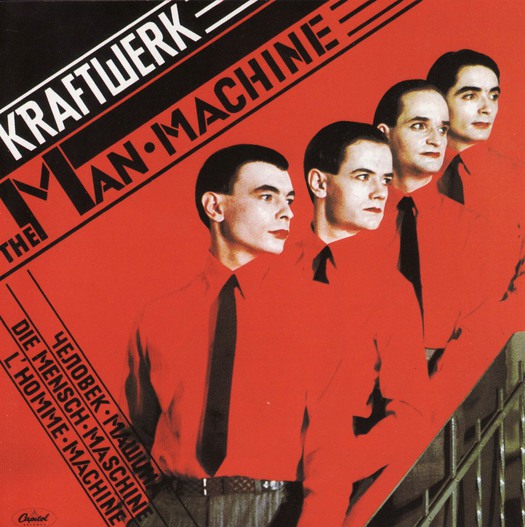
Karl Klefisch, The Man Machine album cover, 1978. Photography by Günter Fröhling
A room titled “Strike a Pose” — surely there was more to it than that self-loving line from Madonna implies? — has big screens with performances by Grace Jones (magisterial), David Byrne in his Big Suit (“If postmodernism means anything is allowed, then I was all for it”) and an operatic Klaus Nomi sporting black lipstick, triangular jacket and pointy po-mo hair. With one eye on sardonic Weimar cabaret and the other on the polymorphous future, Nomi carries off this identity experiment with fabulous assurance; he would have looked right at home lounging in a Memphis living room decorated with George Sowden’s all-over b&w patterns (though the Memphis section of Postmodernism is one point where the curatorial balance seems skewed: there is just too much of it). Back on the video screens there are clips of Kraftwerk, Devo in red “energy dome” hats, Visage (how good “Fade to Grey” still sounds) and Laurie Anderson’s monumentally haunting “O Superman.”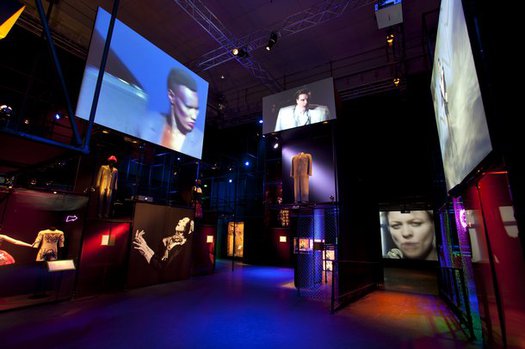
“Strike a Pose,” the music/performance section of Postmodernism: Style and Subversion. Photograph: V&A, London
If this seems like a lot of emphasis on pop music, then I should report that the V&A has released a CD and DVD set to accompany the show, with key tracks from the 1980s and sleeve notes by Adamson, who cautions us against nostalgia — sure! — while proving to be no slouch in the pop-crit department. The curators even use New Order’s “Bizarre Love Triangle” video — “Why can’t we be ourselves like we were yesterday?” — at the end as a kind of melancholy/upbeat finale.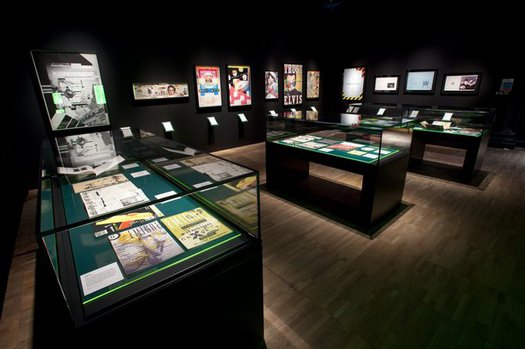
“Style Wars,” the graphic design section of Postmodernism: Style and Subversion. Photograph: V&A, London
Most of the graphic work in the exhibition is gathered in a section titled “Style Wars.” This is the aspect of postmodern design I know best and I was one of the advisers consulted early in the process at a study day at the V&A. I also lent some pieces to the show so I can’t claim detachment here. As with the music, I encountered many of these designs as they appeared, and any understanding I have is strongly tinted by experiencing firsthand how their stylistic codes communicated at the time. The curators zero in on work by Wolfgang Weingart, April Greiman, Emigre, Ed Fella, Paula Scher, Johanna Drucker, Barney Bubbles, Peter Saville, Neville Brody, Malcolm Garrett and Vaughan Oliver, drawing attention to its bricolage, fragmentation and use of quotation, while arguing that it seamlessly blends avant-garde influences with the commercial sphere. However, few of these record covers, posters and magazines are very commercial and their audiences, though still consumers, tended to share the work’s ambivalence. Postmodernism was, nevertheless, an integral expression of the late capitalist economy and the show progresses with inexorable (if depressing) cultural logic toward a section titled “Money.”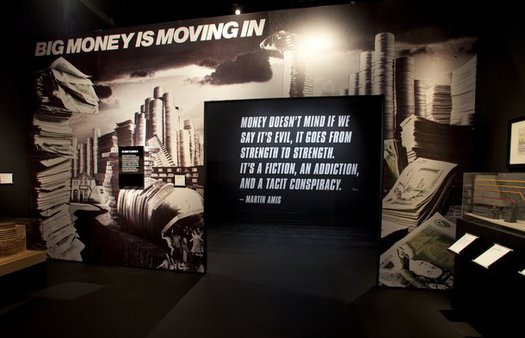
“Money,” Postmodernism: Style and Subversion. Photograph: V&A, London
Little is said about how the graphic pieces were seen in their day as such a controversial departure from the discipline’s norms — older designers still loyal to a romantic but outmoded idea of modernism often voiced an almost visceral hatred of these innovations. What do visitors make of these once troubling experiments now? On my third visit, I saw a man on his own looking at Barney Bubbles’ cover for Music for Pleasure (1977) by The Damned. “Oh, wow, that is so cool,” he sighed out loud, forgetting himself. A friend told me had seen someone making a careful drawing of a magazine I had lent. A copy of New Socialist magazine (1986) with a cover by Brody has been commodified as a T-shirt in the V&A’s shop apparently with the designer’s approval — postmodern irony in action. I suspect that the graphic exhibits, like other parts of the show, are ripe for postmodern plunder by a new Gaga generation of viewers who will savor these artifacts not in terms of cultural ideas that were absorbed long ago, but as a cookie jar of exciting retro styles that can be dipped into at will because that’s the kind of sampling and mashing up we do now as a matter of course.
There is a view of postmodernism — Kunzru expresses it in his essay and the show appears to endorse it by ending in 1990 — that it is essentially a pre-digital phenomenon. Concentrating on postmodernism as temporal style rather than postmodernity as a condition that persists makes it easier to sustain this argument, but developments in 1980s postmodern graphic design undermine the thesis. April Greiman and the designers at Emigre, Rudy VanderLans and Zuzana Licko, embraced the Macintosh in 1984 as soon as it appeared (as work in the show demonstrates), seeing its possibilities not only for increased control of production but as a tool for generating new kinds of visual communication. As processing power increased in the early 1990s, these experiments became more ambitious and complex and this was the period when postmodern ideas about communication were most intensely debated. In those years, the American designer Jeffery Keedy, who isn’t included in the exhibition, was one of postmodernism’s most vigorous and polemical champions, and a scourge of “zombie modernists” who, in his view, continued to think and design as though postmodernism hadn’t happened.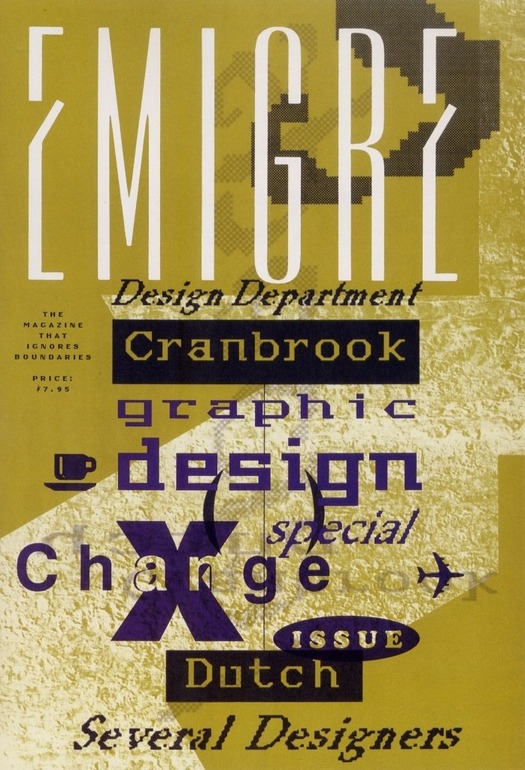
Rudy VanderLans, Emigre no. 10, magazine cover, 1988
Is this the moment to try to rethink or reclaim postmodernism? The movement still arouses a surprising amount of disdain, as though it had been entirely indulgent, frivolous, wasteful, aesthetically misconceived and unnecessary. I confess myself to feeling close to disgust looking at the Alessi tea and coffee services designed by superstar architects — less for the overworked form than for the total vacuity of these over-gilded status symbols. The postmodernism that still seems rich, valuable and durable can be seen in some of the examples I have mentioned, or in the exhibition’s adroitly chosen film clips from Blade Runner and Godfrey Reggio’s Koyaanisqatsi, which portray the city as a sublime illuminated matrix of beauty and terror. The curators’ concluding observation that postmodernism was “marked by a sense of loss, even destructiveness, but also a radical expansion of possibilities” feels right to me. At the end of a grim century, we had lost our illusions, our faith in scientific progress and our belief in the shaping power of “grand narratives.” Yet we continue to benefit from and to explore postmodernism’s expanded cultural terrain.
Godfrey Reggio, still from Koyaanisqatsi, 1982
Could it be, then, that postmodernism’s most basic problem in terms of public perception is the conundrum presented by its name? David Byrne touches on this in a post-script to the exhibition book. “Postmodernism” announces what it isn’t, but it doesn’t tell you what it is, and what the word appears to say isn’t the whole story anyway because, as many theorists have noted, elements of modernism continue within the postmodern. The image it conjures is too negative, while modernism still sounds optimistic and far-seeing, like a cause you could join. No one wants to feel like the superfluous inhabitant of an aftermath. It’s comforting to believe we are post postmodernism. But in a digital world, postmodernity has become everyone’s inescapable reality — “like it or not.” The V&A’s show and book are vital investigations of how we arrived here and the part played by design in the journey.
